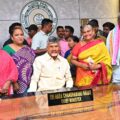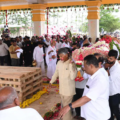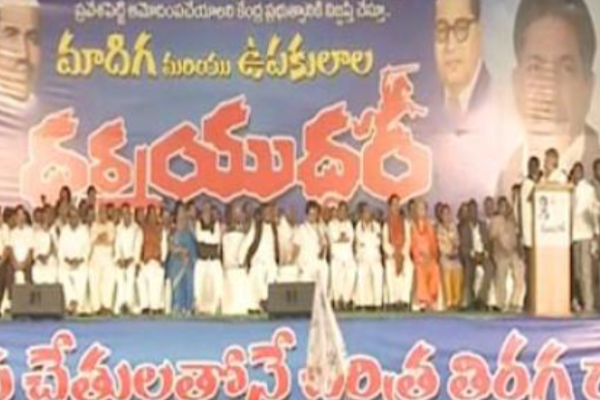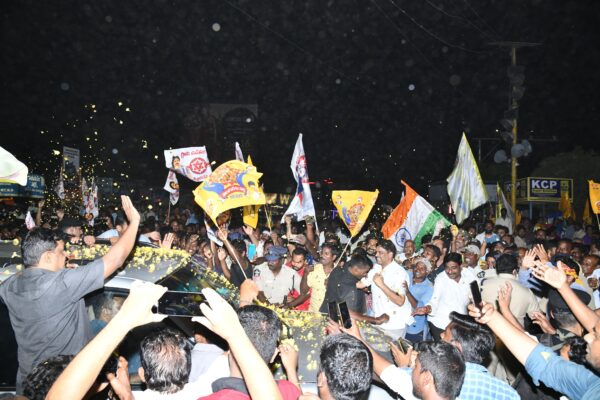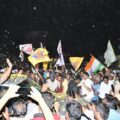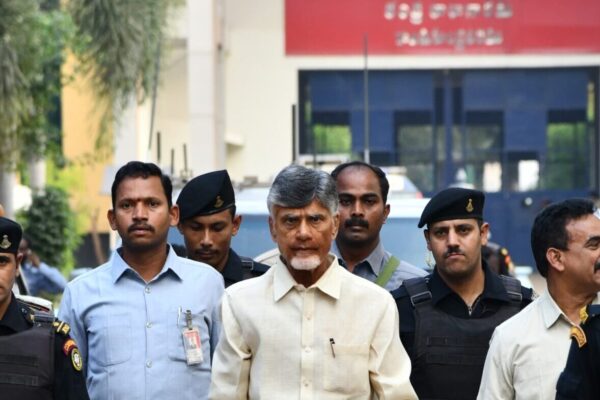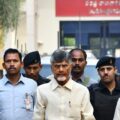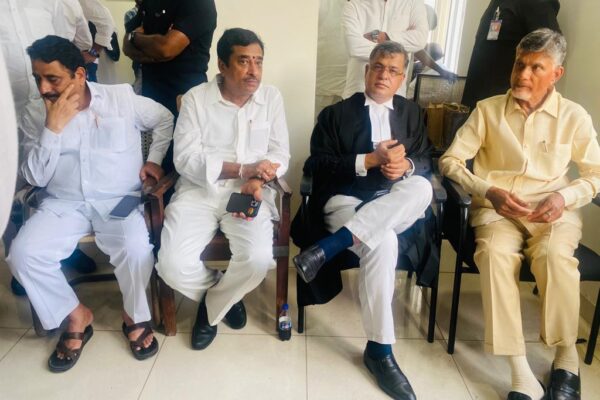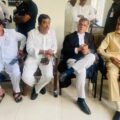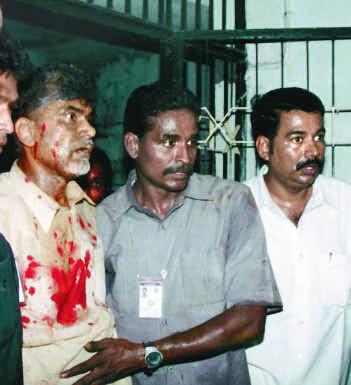
S Nagesh Kumar | Frontline | Oct 24, 2003
Andhra Pradesh Chief Minister N. Chandrababu Naidu has survived the most concerted attempt yet by the People’s War (P.W.) to assassinate him. On October 1, P.W. activists triggered a series of nine powerful Claymore mines, which they are suspected to have planted over a period of time on the ghat road leading to the Tirumala hills from Tirupati, barely minutes after the Chief Minister’s convoy had crossed the Alipiri toll gate downhill at 4-12 p.m.
The impact of the blast was so intense that Chandrababu Naidu’s bulletproof car was hurled into the air and landed on its side. Security personnel extricated the dazed and injured Chief Minister from the mangled car in which he was seated beside the driver. Minister for Information Technology B. Gopalakrishna Reddy, the Telugu Desam Party (TDP) Members of the Legislative Assembly (MLAs) from Tirupati and Puttur, Chadalavada Krishnamurthy and R. Rajasekhara Reddy respectively, all seriously wounded, and the driver were also helped out of the wreckage and rushed to hospitals in Tirupati.
A look at the scene of the attempted assassination left no one in doubt that the Chief Minister had a miraculous escape. Had the bulletproof window of the car given way, the shrapnel from the mines would have caused him far more serious injuries than just a fractured collarbone. Rajasekhara Reddy, who was seated in the rear seat which the Chief Security Officer P. Umapathi was asked to vacate, seems to have borne the brunt of the blast, and is still battling for life.
The Chief Minister, who lost consciousness for a full two minutes after the blast and remained dazed for several hours later, said, “My initial reaction was that the car was involved in an accident and had veered off the road. But, if you look at the scene of the blast, it is difficult to believe that anyone could have survived. I am alive today owing to the good wishes of the people and the benign blessings of Venkateswara (the presiding deity at the Tirumala-Tirupati temple).”
Several leaders, including President A.P.J. Abdul Kalam, Deputy Prime Minister, L.K. Advani, and Karnataka Chief Minister S. M. Krishna, called on Chandrababu Naidu in Hyderabad soon after he returned from Tirupati.
The explosions have exposed grave lapses in the personal security of Chandrababu Naidu, a leader in the `Z’ plus threat category. Apparently the police had not learnt their lessons from an earlier attempt on him in 1998 when P.W. cadres placed Claymore mines in a bullock cart alongside a road on which he was to travel during an Assembly byelection campaign in Karimnagar district. The mines were detected in time but the naxalites triggered them by remote control, injuring the constables present on the spot.
The gaping holes in the security were evident from the failure of the Deep Search Metal Detector (DSMD) to reveal the Claymores although the route had been `sanitised’ before the VIP’s arrival. Routine precautions, such as using an electronic jammer and using a convoy of identical cars bearing identical registration numbers to confuse would-be assassins were not followed. The Centre had offered Chandrababu Naidu NSG cover but he turned it down presumably because its security code would restrict his access to the people.
It was no wonder then that heads began to roll after the incident: Chittoor Superintendent of Police Navin Chand was suspended and the District Collector and Anantapur Range Deputy Inspector-General of Police were transferred. Other standard measures followed were the appointment of a Special Investigation Team headed by D.T. Naik, for an in-depth probe into the blast and a Commission of Inquiry headed by former Uttar Pradesh Director-General of Police Prakash Singh to study the existing security systems.
Speculations about the identity of the assassins were immediately cleared when the P.W. issued a statement claiming responsibility for the attack. Secretary of the State Communist Party of India (Marxist-Leninist) Committee of the People’s War, Ramakrishna, and others justified the attack saying, “Chandrababu Naidu and the State police are enemies of the people. They deserve to be eliminated.”
The P.W.’s admission was not surprising since it had issued death warrants against Chandrababu Naidu, West Bengal Chief Minister Buddhadeb Bhattacharjee, and former Jharkhand Chief Minister Babulal Marandi.
APART from creating fear among political leaders about their personal safety, the attack also served to forge a new kind of solidarity among them. Chandrababu Naidu’s arch-rival and Congress(I) Legislature Party leader Y.S. Rajasekhara Reddy rushed to Tirupati to call on the Chief Minister soon after the incident. He even staged a dharna in the temple town to protest against the failure of the security apparatus.
Political parties have always been wary of openly criticising the P.W.’s policy of eliminating its so-called enemies, for fear of attracting its wrath. With the P.W. attacking the party’s numero uno, the TDP has come out rather strongly saying that the naxalite organisation had no moral right to speak of people’s problems after killing innocent people. While the government was not against anyone, it would hit back at forces that attacked innocent people or destroyed public property, the party said.
The attack has thrown up some disturbing questions, beginning with the image of the State police. Rajasekhara Reddy’s dharna helped underscore the point that the State bureaucracy had become complacent. This laxity may be in no small measure owing to Chandrababu Naidu’s reluctance to wield the stick against some Indian Administrative Service and Indian Police Service officers when the situation demanded.
No action was taken against persons responsible for the security of Panchayati Raj Minister A. Madhav Reddy, who was assassinated by naxalites in a landmine blast in 2000. Madhav Reddy was high on the P.W.’s hitlist for his outspokenness on the issue of naxal violence when he was Home Minister. He was allowed to switch his vehicles in a very casual manner on the night of his murder.
It was on the strong insistence of some Ministers that the Chittoor S.P. has now been suspended. Ironically, security expert S. Subramanyam, a former NSG chief, appointed to inquire into the security aspects, stated that there was no security failure since security was a “mind game not related to weapons”. He said the improvised explosive device (IED) used in this case was unsophisticated and could be prepared even in a kitchen. “There are certain things beyond one’s control,” he said.
But control was one thing that the Chandrababu Naidu government had lost over the bureaucracy and the police. The Chief Minister speaks to District Collectors and S.Ps directly during his weekly videoconferences and takes decisions bypassing Ministers, thus undermining their authority. While he reviews the activity of other departments through performance indicators, the police never seem to come up for scrutiny publicly.
An illustration of the influence wielded by the police bureaucracy in policy making was the abortive talks with the P.W.’s emissaries, Varavara Rao and Gaddar, last year. Some members of the police top brass were accused of scuttling the peace process. In their line of thinking, any attempt to declare a ceasefire in the absence of the P.W.’s willingness to abjure violence would be disastrous. This contentious formulation at the preliminary stage of the talks left no scope for any forward movement.
Moreover, the militarisation of the police has become a cause for concern. A glaring instance was the shooting down of A.P. Civil Liberties Committee (APCLC) leader Ramanathan in September 1985 after naxalites killed an Inspector, Yadigiri Reddy, at the Kazipet railway station. Retributive violence has become commonplace with the police but this “an eye for an eye” policy has never found acceptance among the intelligentsia though expressions in its support are aired in street-talk whenever naxalites attack a popular leader.
The APCLC claims to have catalogued nearly 4,000 deaths at the hands of the police since the naxalite movement began in 1968. Half of these occurred during the past eight years. Figures from other sources show that 5,639 people have died in left-wing extremist violence during the past 35 years. They include 2,504 extremists, 2,616 civilians and 519 security personnel.
Reports frequently appear in the local media about the involvement of police officers in various illegal deals through surrendered naxalites, sullying the department’s image. Kattula Sammaiah, a former P.W. activist, died while being smuggled out of India on a fake passport. He was reportedly accompanied by the son of a top police official.
The attack on Chandrababu Naidu has come at a time when the credibility of the police set-up is at a low in the wake of the multi-crore fake stamp paper scandal in which a TDP MLA, C. Krishna Yadav, was arrested. During the recently concluded Assembly session, Opposition members highlighted how senior police officers sought to shield the prime accused, Abdul Kareem Telgi, and allowed him to escape.
The explosion has served to deflect public attention from the stamp paper scam and provided relief to those TDP leaders who were threatened to be engulfed by it.
For now the landmine explosion has generated a wave of sympathy for the TDP supremo.
